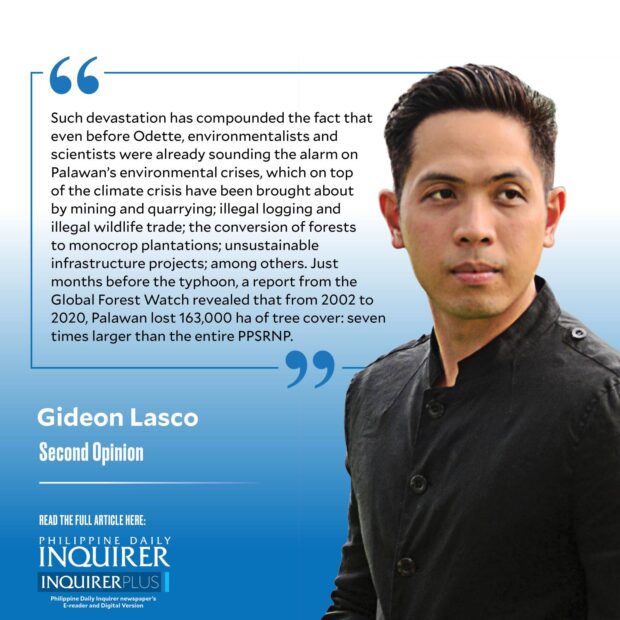Odette’s devastation of Palawan’s forests
Puerto Princesa—Perhaps because it happened in the middle of the pandemic, and it didn’t claim as many lives as Supertyphoon “Yolanda,” Typhoon “Odette”—which struck Northern Mindanao, Visayas, and Mimaropa in December 2021—does not register as strongly in our national discourse, notwithstanding its being the second-costliest typhoon in the country’s history and, with 280 kilometers per hour sustained winds, only the third category 5-equivalent supertyphoon ever to be recorded in the West Philippine Sea.
But Palaweños have vivid memories of that day, a week before Christmas, when a typhoon came with such force that nobody on the island had expected or experienced. And Palawan’s forests carry the imprint and the yet unhealed scars of a devastating supertyphoon: One whose after effects linger, further threatening the already imperiled ecosystems of one of the most beautiful and biodiverse islands in the world.
Having lived in Puerto Princesa a decade ago and having followed its environmental issues since then (including in my capacity as a scientific advisor to the Palawan Council for Sustainable Development), the landscapes of this province are most familiar to me, especially since, as an avid hiker, I’ve also hiked most of its major peaks, from Mount Capoas and Cleopatra’s Needle in the north to Victoria and Mantalingajan in the south. For my Puerto Princesa-based hiking buddies and friends, what was most ominous was the turning of “entire mountains from green to brown” in the wake of Odette’s devastation: a common expression to describe the impact.
Beyond such observations and narratives, a report by the United States Agency for International Development’s Philippine Sustainable Interventions for Biodiversity, Oceans, and Landscapes (USAID SIBOL) project, presented to stakeholders last year, elucidates just how devastating Odette was, particularly for the forests north of Puerto Princesa. Guided by a “green assessment framework,” the data they used were based initially on satellite imaging and modeling, followed by drone surveillance, rapid biodiversity field assessments, and focus group discussions.
Perhaps the most alarming statistic is the scale and magnitude of the damage. In the language of the assessment (see https://tinyurl.com/5fxp52bt for the full report), “About 57 percent (125,581 hectares) was transformed to open forest or nonforest,” with widespread defoliation of forest cover, and high numbers of fallen or uprooted trees. In Puerto Princesa Subterranean River National Park (PPSRNP)—a World Heritage Site and arguably the crown jewel of the island, “More than half (58 percent) or 9,619 ha of the forests were damaged” and in Cleopatra’s Needle Critical Habitat, “Fifty percent (50 percent) or 15,728 ha of forests were reduced into open forests or nonforest overnight.”
Consequently, owing to loss of their tree habitats, the diversion of rivers and streams, among other changes, the toll on biodiversity has likewise been tremendous. Once a regular presence in the mountains, the Palawan hornbill (Anthracoceros marchei) with its distinctive white beak has become a rarity, and the report warns that “[t]he species’ long-term survival is greatly compromised.” The same can be said of the Palawan peacock-pheasant (Polyplectron napoleonis) and even the mighty Almaciga (Agathis philippinensis), which holds profound economic importance not just for the island’s ecosystems but for its indigenous peoples.
“When we speak of typhoons, we think of the number of casualties; the economic cost of the damage,” Elizabeth Maclang, PPSRNP’s park superintendent, told me. “But other species are affected, too, and that’s incalculable loss to our ecosystems.” Her teary-eyed recollection of Odette includes the plight of birds, like a dying “kalaw” (hornbill) found along the tree-obstructed roads, just as overwhelmed by the typhoon as humans.
Such devastation has compounded the fact that even before Odette, environmentalists and scientists were already sounding the alarm on Palawan’s environmental crises, which on top of the climate crisis have been brought about by mining and quarrying; illegal logging and illegal wildlife trade; the conversion of forests to monocrop plantations; unsustainable infrastructure projects; among others. Just months before the typhoon, a report from the Global Forest Watch revealed that from 2002 to 2020, Palawan lost 163,000 ha of tree cover: seven times larger than the entire PPSRNP.
Humans, indeed, have proved to be more destructive than typhoons, but might Odette wake us up into urgent action? How can we realize a Palawan that is greener than ever, as the island and our country face the threat of ever-more-intense typhoons? And how can we cultivate an ecological consciousness that will make people care more about our forests, mangroves, and reefs in the first place?
In my next column, I will reflect further on these questions, drawing on the recommendations of scientists behind the USAID SIBOL report, as well as the insights I am learning from this trip.
—————-
glasco@inquirer.com.ph


















